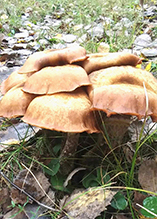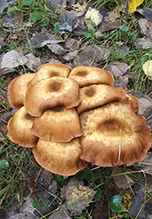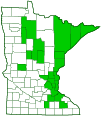Dark Honey Fungus
(Armillaria ostoyae)
Conservation • Description • Habitat • Ecology • Use • Distribution • Taxonomy
Conservation Status |
|
|||||||
| IUCN Red List | not listed |
|||||||
| NatureServe | not listed |
|||||||
| Minnesota | not listed |
|||||||
Description |
||
Dark Honey Fungus is a common, large, edible, gilled mushroom. It occurs in Europe and North America and has recently been discovered in China. In the United States it occurs in the east from Maine to Maryland, west to Minnesota and Illinois, and south along the Appalachian Mountains to northern Georgia. In the west it occurs from western Washington south to west-central California. It also occurs in Colorado. Outside of these ranges there are just a few scattered sightings. It is relatively common in the eastern half of Minnesota. Dark Honey Fungus is found from early September to mid-October in deciduous and coniferous forests. It grows on the ground usually in dense clusters, occasionally singly, on decaying wood debris, dead stumps, dead trees, dead roots, declining trees, and healthy roots. It usually obtains its nutrients from dead wood (saprobic) but can also attack living trees weakened by disease (parasitic). In the west it occurs on the wood and roots of conifers, including hemlock, pine, and spruce, and also but less frequently on hardwoods. In the east and Midwest, it occurs mostly on hardwoods, including birch, oak, and maple, but also on pine. The underground portion (mycelium) forms abundant cords called shoestrings or rhizomorphs. The rhizomorphs are flat, belt-like, dark brown to black, and repeatedly branched. They run through the wood and spread horizontally underground. They can extend a great distance and constitute by far the greatest bulk of the fungus. When it first appears, the cap is hemispherical, bell-shaped, or broadly U-shaped, soon becoming convex. The margins are rolled under. As it matures it spreads out. Mature caps are broadly convex to nearly flat and 19⁄16″ to 4″ (4 to 10 cm) in diameter. They may be dark brown, cinnamon brown, or yellowish tan. They are covered with numerous very small, tan, brown, or black scales. The scales are especially dense in the center. The margins are turned downward and are sometimes finely lined (striate). The gills are white or cream colored when young, becoming grayish-orange or cinnamon brown in age. They are “rather” closely spaced, and they are broadly attached to the stalk (adnate) or slightly run down the stalk (decurrent). They are thick where they attach to the stalk, becoming thin at the margin of the cap. The stalk is club shaped and whitish when young. At maturity, the stalk is 2″ to 4″ (5 to 10 cm) long and 3⁄16″ to ⅝″ (5 to 15 mm) thick, more or less the same thickness from top to bottom. It is whitish above but becomes brownish to gray or nearly black at the base. It is covered with brown, hair-like fibers (fibrils). There is a thick, well-developed ring of tissue, the remains of the partial veil, on the upper part of the stalk. The ring is whitish, and it sometimes has a ring of tan or chestnut brown spots on the margin below. The flesh is thick, firm, and white. It does not change color when sliced. It is edible. The spore print is white. |
||
Similar Species |
||
Habitat and Hosts |
||
Deciduous and coniferous forests |
||
Ecology |
||
Season |
||
Early September to mid-October |
||
Use |
||
In the early 1990s a huge underground mycelium of Armillaria ostoyae was found covering 37 acres in the Upper Peninsula of Michigan. Molecular genetics showed the mycelium to be about 1,500 years old. It came to be known as the “Humongous Fungus”. It became a popular tourist attraction, and it spawned an annual fungus festival. At the time of its discovery, it was thought to be the largest organism on earth, a title formerly held by Pando, the quaking aspen grove in Utah. Since that time, three other organisms have held that title. The current (2023) holder is the marine plant Posidonia australis in Shark Bay, Australia. |
||
Distribution |
||||
|
Sources Some authorities treat Armillaria solidipes and Armillaria ostoyae as distinct species, while others treat Armillaria solidipes as a synonym of Armillaria ostoyae. The map at left includes sightings and records of both. |
|||
| 11/1/2023 | ||||
Occurrence |
||||
Common |
||||
Taxonomy |
|||
| Kingdom | Fungi (Fungi) | ||
| Subkingdom | Dikarya | ||
| Phylum | Basidiomycota (Basidiomycete Fungi) | ||
| Subphylum | Agaricomycotina (Higher Basidiomycetes) | ||
| Class | Agaricomycetes (Mushrooms, Bracket Fungi, Puffballs, and Allies) | ||
| Subclass | Agaricomycetidae | ||
| Order | Agaricales (Common Gilled Mushrooms and Allies) | ||
| Suborder | Marasmiineae | ||
| Family | Physalacriaceae | ||
| Genus | Armillaria (honey mushrooms) | ||
This species was previously known in Europe by various authors under several competing names. The controversy was settled when it was assigned the name Armillariella ostoyae by Henri Romagnesi in 1970. In 1973 it was transferred to the genus Armillaria. Later studies (Anderson and Ullrich, 1979; and Anderson et al., 1980) identified several North American species that were compatible with European species – they were conspecific. One of those was Armillaria ostoyae. Since then, the fungus causing important root rot in conifers in both Europe and northern North America has gone by that name. A recent article (Burdsall and Volk, 2008) noted that the species had been described in 1900 by Charles Horton Peck as Armillaria solidipes. Under the rules of the International Code of Botanical Nomenclature (ICBN), now called the International Code of Nomenclature for algae, fungi, and plants, the older name has precedence, and Armillaria ostoyae became Armillaria solidipes. The change was problematic, resulting in the two names being used inconsistently and sometimes interchangeably. A more recent article (Redhead et al., 2011) proposed preserving the name Armillaria ostoyae. The proposal was adopted, the name Armillaria ostoyae was reinstated, and Armillaria solidipes is now a synonym. |
|||
Synonyms |
|||
Agaricus obscurus Agaricus occultans Armillaria obscura Armillariella obscura Armillaria polymyces Armillaria solidipes Armillariella ostoyae Armillariella polymyces Armillariella solidipes |
|||
Common Names |
|||
Dark Honey Fungus |
|||
Glossary
Hypha
A thread-like cell of a fungus that is the main mode of vegetative growth: the basic structural unit of a multicellular fungus. Plural: hyphae. Collectively, the hyphae of a fungus is the mycelium.
Mycelium
The vegetative part of a fungus; consisting of a mass of branching, thread-like hyphae, through which a fungus absorbs nutrients from its environment; and excluding the fruiting, reproductive structure.
Parasitic
Obtaining nutrients from another living organism.
Partial veil
A protective covering over the gills or pores of a developing mushroom. At maturity it disappears, collapses into a ring around the stalk, or wears away into a cobwebby covering and ring zone.
Rhizomorph
A root-like, mycelial cord of a fungus, formed from vessel hyphae surrounding sheathing hyphae, and capable of transferring nutrients over long distances.
Saprobic
A term often used for saprotrophic fungi. Referring to fungi that obtain their nutrients from decayed organic matter.
Striate
Striped or grooved in parallel lines (striae).
Visitor Photos |
|||||
Share your photo of this fungus. |
|||||
| This button not working for you? Simply email us at info@MinnesotaSeasons.com. Attach one or more photos and, if you like, a caption. |
|||||
Luciearl |
|||||
Many, many of these and easily 5-6" diameter. |
|||||
 |
 |
||||
MinnesotaSeasons.com Photos |
|||||
|
|||||

Slideshows |
||

Visitor Videos |
|||
Share your video of this fungus. |
|||
| This button not working for you? Simply email us at info@MinnesotaSeasons.com. Attach a video, a YouTube link, or a cloud storage link. |
|||
Other Videos |
|||
| Armillaria ostoyae, wild Mushroom Search, edible wild mushrooms Mushroom |
|||
About
Aug 27, 2020 Armillaria is a genus of about 35 species of parasitic fungi in the family Physalacriaceae (order Agaricales), found throughout northern North America and Europe, principally in forests of hardwoods or mixed conifers. In suitable environments, members of this genus may live for hundreds of years, and certain specimens have been identified as among the largest and oldest living organisms. WARNING Keep in mind that identifying a wild mushroom over the internet is extremely difficult. If you plan to collect fungi to be eaten, misidentified mushrooms can make you sick or even kill you. Be very careful, do not eat mushrooms you are not 100% certain that they are edible. Use many resources, and be skeptical of your own conclusions. The Mushroom chanel takes no responsibility for damage caused by wrong identifications. |
|||
| Humongous Fungus: The Biggest Thing To Ever Live Animalogic |
|||
About
May 21, 2021 The Humongous Fungus is a the largest living organism in the world, and the biggest one is the size of 1800 contiguous football fields. |
|||

Created: 11/2/2023
Last Updated:


